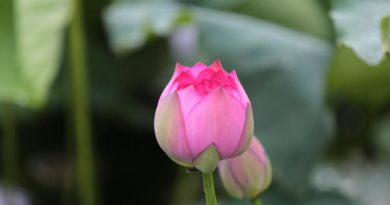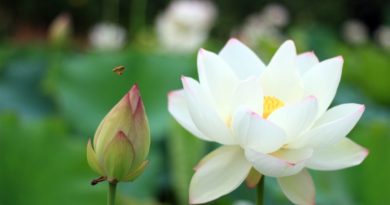Buddhist Outlook On Daily Life – 7. The Dhamma
BUDDHIST OUTLOOK ON DAILY LIFE – 7. THE DHAMMA
The second of the Three Gems Buddhists take their refuge in is the Dhamma. When they take their refuge in the Dhamma they say: ‘Dhammam saranam gacchami‘, which means, ‘I go for refuge to the Dhamma.’
What does the word dhamma mean? Most people think that dhamma means doctrine, but the word dhamma has many more meanings. Dhamma means everything which is real, no matter whether it is good or bad. Dhamma comprises, for example, seeing, sound, greed and honesty. We cannot take our refuge in every dhamma; for instance, we cannot take our refuge in greed or hate. We cannot even take for refuge our parents, our husband or wife, because we are bound to be separated from them sooner or later.
Can we take our refuge in our good deeds? The effect of a good deed is never lost, since each good deed will bring its fruit accordingly. In the ‘Samyutta Nikaya’ (Sagatha-vagga, Chapter I, part 8, par. 5) we read that a deva asks the Buddha how a man should live so that he does not have to fear life in another world. The Buddha answers:
Let him but rightly set both speech and mind,
And by the body work no evil things.
If in a house well stored with goods he dwell,
Let him have faith, be gentle, share his goods
With the others, and be affable of speech.
In these four qualities if he persist,
He need not fear life in another world.
A good deed can cause a happy rebirth such as birth the human plane of existence, or in a heavenly plane, and thus one need not fear life in another world. However, even a heavenly plane is not a permanent refuge. Life in a heavenly plane may last very long, but it is not permanent. There may be rebirth in ‘woeful planes’ after one’s lifespan in a heavenly plane is terminated, depending on one’s accumulated good and bad deeds. Each deed will bring its own result : a wholesome deed will bring a pleasant result and an unwholesome deed will bring an unpleasant result. Some deeds may produce a result in this life, other deeds may produce a result in a later life. The accumulated unwholesome and wholesome deeds may cause births in different planes of existence at different times. In the ‘Samyutta Nikaya’ ( Sagatha-vagga, Chapter III, part 2, Childless) we read about someone who gave alms to a Pacceka Buddha. Because of this good deed he was reborn in heaven seven times and after that in the human plane, which is also kusala vipaka. However, he killed his nephew because he wanted his brother’s fortune. This ill deed caused him to be reborn in hell. Thus he received the results of wholesome deeds and of unwholesome deeds at different times.
As long as all defilements and latent tendencies have not been eradicated, there will be rebirth in different planes of existence. Even those who are reborn in heavenly planes still have defilement’s and latent tendencies. Birth is sorrow, no matter on what plane; birth will be followed by death. We read in the ‘Samyutta Nikaya’ (Nidana-vagga, Chapter XV, part 1, par. 3) that the Buddha said to the monks:
Incalculable is the beginning, monks, of this faring on. The earliest point is not revealed of the running on, faring on, of beings cloaked in ignorance, tied to craving.
As to that, what do you think, monks? What is greater:- the flood of tears shed by you crying and weeping as you fare on, run on this long while, united as you have been with the undesirable, sundered as you have been from the desirable, or the waters in the four seas?
… For many a long day, monks, have you experienced the death of mother, of son, of daughter, have you experienced the ruin of kinfolk, of wealth, the calamity of disease. Greater is the flood of tears shed by you crying and weeping over one and all of these, as you fare on, run on this many a long day … than are the waters in the four seas.
Only when all defilements are eradicated will there be no cause any more which can produce a next life, and thus there will be no more rebirth. That means the end of all sorrow. Nibbana is the end of rebirth because nibbana is the end of defilements. Therefore one can truly take one’s refuge in nibbana. In the suttas nibbana is called ‘the deathless’. We read in the ‘Samyutta Nikaya’ (Maha-vagga, Kindred Sayings on the Way, Ignorance, par. 7) that a monk said to the Buddha:
‘”The deathless! The deathless!” Lord, is the saying. Pray, Lord, what is the deathless, and what the way to the deathless?’
‘That which is the destruction of greed, the destruction of hatred, the destruction of ignorance, monk- that is called “the deathless”. This same ariyan eightfold way is the way to the deathless…’
Nibbana is the dhamma which is the second Gem. Nibbana is a Gem of the highest value, because there is nothing to be preferred to complete freedom from all sorrow. Nibbana is real: even if one cannot yet experience nibbana, it should be considered the goal of life. If one follows the right Path one might realize nibbana even during this life.
People may think that it is not very desirable not to be born again. If we have not attained nibbana we cannot imagine what nibbana is like. It does not make much sense therefore to speculate about nibbana. At the present moment we can experience our defilements; we can experience the sorrow which is caused in the world by greed, hatred and ignorance. We read in the ‘Samyutta Nikaya’ (Sagatha-vagga, Chapter III, part 3, par. 3, The World) that King Pasenadi asks the Buddha:
‘How many kinds of things, Lord, that happen in the world, make for trouble, for suffering, for distress?’
The Buddha answered:
‘Three things, sire, happen of that nature. What are the three? Greed, hatred and ignorance:- these three make for trouble, for suffering, for distress.’ Who does not want to be free from suffering caused by greed, hatred and ignorance? Those who want to become free from all defilements take their refuge in nibbana.
What is the Path leading to nibbana? Nibbana cannot be attained merely by wishing to achieve it. Can people attain nibbana by doing good deeds? Even when one performs good deeds there can still be the idea of self. Good deeds without the right understanding of realities cannot eradicate the belief in a self and the other defilements. Thus they cannot lead to nibbana. Only vipassana leads to the eradication of all defilements.
One may wonder whether it is necessary, in addition to developing vipassana, to do other good deeds. The answer is that, the wisdom developed in vipassana helps us to be kind and considerate to other people in our deeds and speech. We learn to use every opportunity to eradicate unwholesomeness. Every time there is awareness of the nama or rupa while one is observing precepts or doing other kinds of good deeds, one is on the Path leading to nibbana.
The development of vipassana is a lifetask for most of us, since we are not used to the direct experience of the nama or rupa which appears through one of the five senses or through the mind. We are used to thinking of realities from a past experience or those which might present themselves in the future. We should not expect to learn awareness in one day or even within one year. We cannot tell how much progress is made each day, because wisdom accumulates very gradually.
We read in the ‘Samyutta Nikaya’ (Khandha-vagga, Middle Fifty, part 5, par. 101, Adze-handle) that the Buddha said to the monks:
By knowing, monks, by seeing is, I declare, the destruction of the asavas, not by not knowing, by not seeing …
Suppose, monks, in a monk who lives neglectful of self-training there should arise this wish: ‘O that my heart were freed without grasping from the asavas.’ Yet for all that his heart is not freed from the asavas. What is the cause of that?
It must be said that it is his neglect of self-training. Self-training in what? In the four applications of mindfulness … in the ariyan Eightfold Path.
… In the monk who dwells attentive to self-training there would not arise such a wish as this: ‘O that my heart were freed from the asavas without grasping’; and yet his heart is freed from them. What is the cause of that?
It must be said it is his attention to self-training … Just as if, monks, when a carpenter or carpenter’s apprentice looks upon his adze-handle and sees thereon his thumbmark and his finger-marks he does not thereby know: ‘Thus and thus much of my adze-handle has been worn away today, thus much yesterday, thus much at other times.’ But he knows the wearing away of it just by its wearing away.
Even so monks, the monk who dwells attentive to self-training has not this knowledge: ‘Thus and thus much of the asavas has been worn away today, thus much yesterday, thus much at other times’: but he knows the wearing away of them just by their wearing away.
When wisdom is highly developed nibbana can be realized. There are four stages of enlightenment or realization of nibbana. Defilements are so deeply rooted that they can only be eradicated stage by stage. In the first stage there is no more wrong view of ‘self’, but there is still attachment, aversion and ignorance. Only at the last stage of enlightenment, the stage of the arahat, are all defilements and latent tendencies eradicated completely. When one has attained the stage of the arahat there will be no more rebirth.
The citta which experiences nibbana is a ‘lokuttara citta’. There are two types of citta for each of the four stages of enlightenment, thus there are eight lokuttara citta. Nibbana and the eight lokuttara cittas are the ‘nava lokuttara dhamma’, or ‘nine supramundane dhammas’. These nava lokuttara dhammas are the second Gem, the Dhamma to which one goes for refuge. When one takes one’s refuge in the second Gem, one considers it the goal of one’s life to develop the wisdom which can eventually eradicate all defilements.
There is a tenth dhamma included in the second Gem: the teachings of the Buddha. The teachings can lead people to the truth if they study them with right understanding and if they practise according to what is taught. One should study the whole of the Buddha’s teachings. If one studies only a few suttas one will not clearly understand what the Buddha taught. Many times a sutta merely alludes to things which are explained in detail in other parts of the Tipitaka. It is useful to study the commentaries to the Tipitaka as well, because they explain the Buddha’s teachings. The teachings are our guide since the Buddha passed away.
We read in the ‘Gopakamoggallan-sutta’ (Majjhima Nikaya III, Devadaha-vagga) that after the Buddha’s death a brahman asked Ananda what the cause was of the unity of the monks. He said:
‘Is there, good Ananda, even one monk who was designated by the Lord who knew and saw, perfected one, fully Self-Awakened One, saying: “After my passing this one will be your support,” and to whom you might have recourse now?”
‘There is not even one monk, brahman, who was designated by the Lord who knew and saw, perfected one, fully Self-Awakened One, saying: “After my passing this one will be your support,’ and to whom we might have recourse now.’
‘But is there even one monk, Ananda, who is agreed upon by the Order and designated by a number of monks who are elders, saying: “After the Lord’s passing this one will be our support,” and to whom you might have recourse now?’
‘There is not even one monk, brahman, who is agreed upon by the Order … and to whom we might have recourse now.’
‘But as you are thus without a support, good Ananda, what is the cause of your unity?’
We brahman, are not without support; we have a support, brahman. Dhamma is the support.’
In the ‘Anguttara Nikaya’ (Book of the Threes, Chapter VI, par. 60, Sangarava) we read that the Buddha speaks to the brahman Sangarava about three kinds of miracles: the miracle of ‘superpower’, such as diving into the earth or walking on water, the miracle of thought-reading and the miracle of teaching. The Buddha asked him which miracle appealed to him most. Sangarava answered:
Of these miracles, master Gotama, the miracle of superpower … seems to me to be of the nature of an illusion. Then again as to the miracle of thought-reading … this also, master Gotama, seems to me to be of the nature of an illusion. But as to the miracle of teaching … of these miracles this one appeals to me as the more wonderful and excellent.
The teachings are the greatest miracle because they can change a person’s life. Dhamma brings right understanding, so that one is able to walk on the Path which leads to the end of the cycle of rebirth, to nibbana.
The Buddha’s teachings do not appeal to everybody. Many people find it difficult to think in a way which is different from the way they used to think. They do not like the idea that there is no self. They want to control their mind even though they can find out that this is impossible. The Buddha knew how difficult it is for people to change their way of thinking. In the ‘Discourse to Vacchagotta on Fire’ (Aggi-Vacchagotta-sutta, Majjhima Nikaya II, Paribbajaka-vagga) we read that the Buddha said to Vacchagotta:
You ought to be at a loss, Vaccha, you ought to be bewildered. For, Vaccha, this dhamma is deep, difficult to see, difficult to understand, peaceful, excellent, beyond dialectic, subtle, intelligible to the wise; but it is hard for you who are of another view, another allegiance, another objective, of a different observance, and under a different teacher.
Dhamma is deep and difficult to understand. People cannot understand Dhamma if they still cling to their own views. If they would really study the teachings and persevere in the practice of what is taught, they would find out for themselves whether one can take one’s refuge in the Dhamma. When we have experienced that what the Buddha taught is reality, even if we cannot yet experience everything he taught, we do not want to exchange our understanding for anything else in life. If we have the right understand of realities and if we develop wisdom, we will have Dhamma as a support. Thus we take refuge in the Dhamma.









